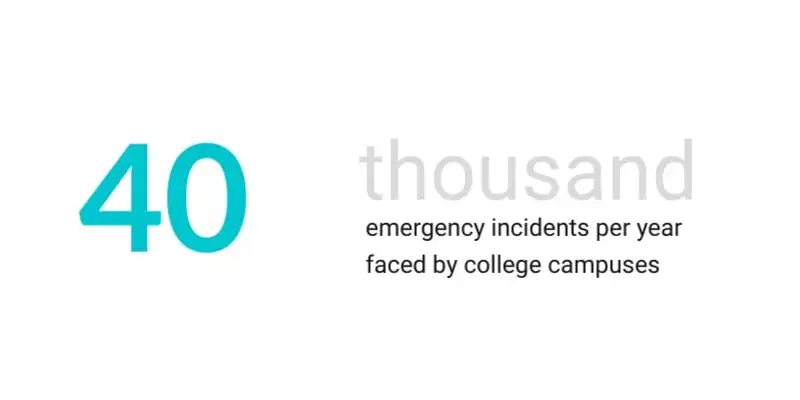Going off to college is an important milestone for many young people in America. Unfortunately, college campuses are not immune to emergencies.
According to the Office of Postsecondary Education, college campuses across the United States deal with over 40,000 emergency incidents yearly. Although this number varies from campus to campus, college administrators should know this statistic and plan their college mass notification system accordingly.
This article will explain why a campus mass notification system is essential for colleges and then detail what characteristics and features college administrators should look for in an emergency alert system.
Why Are Mass Notification Systems for Higher Education Essential?
In today’s increasingly unpredictable world, mass notification systems are essential for higher education institutions to safeguard their students, staff and faculty. They alert students, faculty, staff, and visitors of emergencies and essential safety information.
Additionally, under The Clery Act, higher education institutions must issue immediate campus emergency alerts when situations posing a threat to the health or safety of the campus community are identified.
While modern mass notification alert systems aren’t a requirement of The Clery Act, they are widely used by higher education institutions to communicate emergency information effectively.
How do colleges use their mass notification systems?
Examples of when mass notification systems send alerts include:
- active shooter
- school out alert
- severe weather warnings
- dangerous activity
- power outages
- missing person alert
- traffic flow disruptions (building or pathway closures)
- biohazard risks
- campus wide information and more.
7 Top Features of A Comprehensive Campus Mass Notification System
Emergency Mass Notification Systems (EMNS) can have various features and capabilities depending on the user’s needs, budget and notification goals.
For college campuses, a notification system must quickly alert large volumes of people across numerous channels. To achieve this level of agility, specific functions must be included in every college’s mass notification system.
Seven essential features of top-class EMNS are detailed below.
1. Multichannel Broadcasting
Mass notification systems in higher education institutions must integrate several broadcasting channels, such as email, text messages, voice calls and social media. This ensures everyone in the campus community knows about emergencies.
| Check out these other blogs about school alert systems: |
Examples of channels that should be part of a college’s alert system include the following:
- Text messages
- Website announcements
- Mobile devices and applications
- Public address systems
Additionally, robust notification systems like Activate can integrate with other campus alert systems, such as emergency lights, fire alarms, or automated doors. Activate connects directly to local emergency dispatchers, who can contact the appropriate emergency responders.
2. Scalability
A college campus is ever-changing and therefore requires a messaging alert system that can grow with the campus needs as they evolve.
3. Installation and Maintenance
How a school’s emergency notification system is designed, implemented and subsequently maintained will considerably impact its emergency messaging capabilities and ease of use. Finding the right partner to evaluate your notification needs, budget, and goals is best to get the most out of your alert messaging system.
Examples of what to look for in a notification service provider include:
- Full technical training
- Campus integration
- Protocol development
- 24/7 monitoring
- Post-incident reports
- Automatic updates

4. Geofencing
A geofencing feature should be used to define coverage areas to ensure messages are sent to the right people in the right places at the right time.
5. Customized Messaging
Customizable and pre-written messages allow for flexibility when responding to any situation on campus. This will enable administrators to quickly communicate important information without having to type it in every time an incident occurs.
When Seconds Count, Can You Rely on Your School Alert System?
ACTIVATE is a fully integrated comprehensive school alert system that lets you initiate your emergency protocol at the click of a button
Find Out More
6. Automated Alerts
A mass emergency notification system should be able to send automated alerts based on predefined criteria. This allows for immediate notifications with minimal effort from campus administrators.
7. Integration With Other Systems
A college notification system needs to be able to integrate and communicate with other campus systems, such as surveillance cameras.
Global CTI: Leaders in Mass Notification Systems for Schools
Global CTI proudly provides college campuses with top-notch mass notification systems. Our Activate platform is the perfect solution for any campus looking to keep its community safe and well-informed.
Our EMNS options provide a range of features, such as multichannel broadcasting, scalability, geofencing, customizable messaging, automated alerts and integration with other campus systems. Contact us today to learn more.
